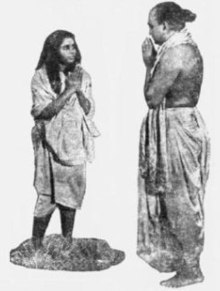Saint Nandanar- The story of Dalit Saint Nandanar
 |
| K. B. Sundarambal (left) as Nandanar and Maharajapuram Viswanatha Iyer as Vediyar in the 1935 film Nandanar. |
Tamil Periya Puranam, the great epic is a Tamil poetic account depicting the legendary lives of the sixty-three Nayanars, the canonical Tamil poets compiled during the 12th century. One poem refers to the story of Nandanar, a Pulaiyar, an untouchable.
It is said that he used to supply leather for drum and straps, strings for lutes, and various instruments for the worship of God. He was known for his deep devotion to Siva and was longing to visit the Nataraja temple of Chidambaram but feared that his low birth would serve a hindrance to his temple entry.
He post-poned his visit daily and for this reason he is also known as Tirrunalaipovvar (“He who will go tomorrow”). One day he gathered enough courage and started out for Chidambaram, and on reaching was overwhelmed by both happiness and despair outside the high wall of the temple.
He wasn’t allowed in because of his Caste. On hearing his wails it is written that God himself appeared before the priests and commanded them to light a fire and lead Nandanar into the inner sanctum of the temple.
Many Dalits have criticized Nandanar because spiritually he never dared to go beyond the worship of stone idols and for his what is seen as meek begging before Brahmins. However, some see this as an act of courage, since for most Dalits of that time, entering a temple could mean instant murder by the upper castes.
He also won for his people – the freedom to sing. Even if he only sang of his pain as a Dalit and his longing for God, still for the first time a Dalit voice was heard of popularly. Nandanar, by the sublime sweetness of his Tamil, compelled Indian society and Indian literature to accept the entrance of a great singer.
CASTE REVOLUTIONS OF YESTERYEAR: NANDANAR
Nandanar was born in the Dalit slum village of Athanur of Tamil Nadu. He is known as the first hero in the Dalit resistance struggle. Nandanar lived in a time when Dalit voices were never heard in social life. It was an era in which Dalits gained only partial freedom by converting to Buddhism or Jainism.
However for Dalits trapped in the grip of the Puranic, Hindu religion, not only were they never to be heard, they were considered too vile to ever be seen by the rest of society. Many Dalits have criticized Nandanar because spiritually he never attained realization to go beyond the worship of stone idols. Socially also he is criticized for his meek begging from arrogant brahmins to be allowed to worship the idol of Shiva in the temple city of Chidambaram.
Such critics fail to realize that for the first time in history a Dalit tried to enter a Brahmin temple. For a Dalit, it was a crime to even step foot in the urban complex of Chidambaram. This was an act of unbounded courage, since for most Dalits it meant instant murder by the upper castes.
Second, all Dalits are forever indebted to Nandanar, because he won for them their very first freedom – the freedom to sing. Even if he only sang of his pain as a Dalit and his longing for Shiva, still for the first time a Dalit voice was heard in India. Before Nandanar, Dalit voices were completely silenced in social and cultural life. Nandanar, by the overwhelming power of his devotion, by the sublime sweetness of his Tamil, compelled Indian society and Indian literature to accept the entrance of a great Dalit devotee. It was a historic first for Dalits.
While it is true that Nandanar did not transcend the superstitious stone idol worship of his times, his bhakti transcends the bhakti of any Dalit of the 20th century. Moreover Nandanar was the first Dalit martyr. The Brahmins of Chidambaram, afraid of the power of his devotional songs in the society, set him on fire and burned him to death. Yet even in death Nandanar was victorious.
The people of Tamil Nadu never forgot the devotional sublimity of his songs. Even Brahmin writers were forced to acknowledge the devotional greatness and sanctity of Nandanar. This in itself was a revolution in the Dark Age of the Puranic regime.
Reference- Wikipidia, Dalit History month

